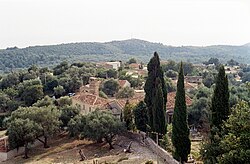Vuno
| Vuno | |
|---|---|
| Village | |
 |
|
| Coordinates: 40°8′23″N 19°41′37″E / 40.13972°N 19.69361°ECoordinates: 40°8′23″N 19°41′37″E / 40.13972°N 19.69361°E | |
| Country |
|
| County | Vlorë |
| Municipality | Himarë |
| Administrative Unit | Himarë |
| Population | |
| • Total | 486 |
| Time zone | CET (UTC+1) |
| • Summer (DST) | CEST (UTC+2) |
Vuno is a village on the Albanian Riviera. It is located in the Vlorë County, Albania, along the road between Himarë and Dhërmi. Since 2014 Vuno is part of the municipality Himarë.
It is said that because of the village's situation on the hills, which ascend to about 300 metres (980 ft), the village's name derives from the Greek word Vouno (Greek: Βουνό), meaning "mountain".
The region was inhabited by the Chaonians in the ancient period.
In 1720, the villages of Himara, Palasa, Ilias, Vuno, Pilur and Qeparo refused to submit to the Pasha of Delvina.
In 1873 a Greek school with 80 pupils was already operating in the village. Greek education was expanded the following years and in the 1898-1899 school season three schools were opeating in Vuno: a primary, a secondary (Hellenic) and a girls' school. Education was sponsored by various distinguished personalities and the diaposra members who originated from Vuno, as well as from adjucent settlements. These schools appear to have ceased their operation in 1913. Greek school classes in Vuno were housed in an imposing building, however after the incororation of the village in the newly established Principality of Albania, Greek education was prohibited by state policies.
During the First Balkan War, on November 18, 1912, Himara revolted under Spyros Spyromilios and expelled the Ottoman forces. After the Albanian Declaration of Independence in Vlorë, on November 28, Himarë was constantly attacked by Albanian units without success and the area remained under Greek control until the end of the Balkan Wars. Upon the Greek Army evacuation from Himara, the locals undertook the defense of the region. The Himariotes rebels were joined by volunteers from neighbouring villages and defectors of the army, that set up points on the roads leading to Himara and continued the resistance. Athanasios Liampou Kotsou commanded a volunteer band and the residents in Vuno. The rebel bands in Vuno were assisted by a Greek revolutionary band numbering 55 fighters commanded by guerrilla leader Georgios Tsolakes. The Vuno troops were unable to enter Vranisht on 30 June due to strong Albanian resistance, but they managed to capture it the next day. Tsolakes and other Himariote leaders were later killed in action.
...
Wikipedia

